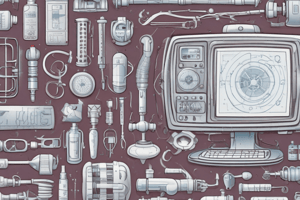Podcast
Questions and Answers
What is the primary characteristic of eczema?
What is the primary characteristic of eczema?
- Thick scars resulting from excessive tissue growth
- Infection of the skin caused by a fungus
- Redness, blisters, scabs, and itching (correct)
- Localized loss of skin pigmentation
Which condition is characterized by minute pinpoint hemorrhages under the skin?
Which condition is characterized by minute pinpoint hemorrhages under the skin?
- Gangrene
- Scabies
- Petechiae (correct)
- Urticaria
How is psoriasis primarily identified?
How is psoriasis primarily identified?
- Red lesions covered with silvery scales (correct)
- Flesh-colored raised areas
- Patches of milky-white skin
- Crusted pustules that rupture
Which skin condition is caused by bacterial invasion after tissue death due to loss of blood supply?
Which skin condition is caused by bacterial invasion after tissue death due to loss of blood supply?
Urticaria is typically characterized by which feature?
Urticaria is typically characterized by which feature?
Which skin condition results from a viral infection?
Which skin condition results from a viral infection?
What is a key feature of keloid formation?
What is a key feature of keloid formation?
Which condition is caused by mites?
Which condition is caused by mites?
What distinguishes tinea from other skin conditions?
What distinguishes tinea from other skin conditions?
Which condition results in localized loss of skin pigmentation?
Which condition results in localized loss of skin pigmentation?
Study Notes
Medical Symbols and Terms
- Right: ®, Not/None/Null: ∅
- Left: Ⓛ, Change: △
- Before: ā (from "ante"), Primary: 1°
- After: p̄ (from "post"), Secondary: 2°
- With: c̅ (from Spanish "con"), Treatment/Prescription: ℞
- Without: s̅ (from Spanish "sin"), Greater than: >
- Every: q, Less than: <
Gender Symbols
- Male: ♂, Positive: +⨁
- Female: ♀, Negative: - ⊖
- Increase: ↑, Decrease: ↓
- Moving toward: →, Standing: (Position), Sitting: (Position), Lying down: (Position)
Common Medical Abbreviations
- Pt or pt: Patient
- c/o: “Complains of” or “complaints of”; used in patient documentation
Medical Terminology Building Blocks
-
Prefixes:
- a-/an-: Not, without
- pre-: Before
- post-: After
- hypo-: Under, below
- hyper-: Over
- sub-: Under, below
- epi-: Above
- inter-: Between, among
- intra-: Within, inside
- micro-: Small
- macro-: Large
- dys-: Bad, painful, difficult
-
Roots:
- neur/o: Nerve, nervous system
- ophthalm/o: Eye, vision
- ot/o: Ear, hearing
- dermat/o: Skin
- cardi/o: Heart
- pulmon/o: Lung
- hepat/o: Liver
- nephr/o: Kidney
- gastr/o: Stomach
- oste/o: Bone
- my/o: Muscle, muscle tumor
- arthr/o: Joint
-
Suffixes:
- -ac, -ic, -al, -ous, -tic: Related to
- -ectomy: Excision, removal
- -itis: Inflammation of
- -logist: Specialist in study of
- -logy: Study of
- -oma: Tumor mass
- -osis: Abnormal condition
- -pathy: Disease condition
- -scope: Instrument to observe
- -scopy: Visual examination
- -gram: To record
- -graphy: Process of recording
Major Functions of the Skeletal System
- Protection: Ribs protect the heart and vital organs.
- Storage: Bones hold minerals and fat.
- Support: Provides body shape and structure.
- Blood cell formation: Bone marrow produces blood cells.
Skeleton Overview
- Axial Skeleton:
- Contains 80 bones.
- Comprises skull, thoracic cage (ribs, sternum), and vertebral column.
- Appendicular Skeleton:
- Contains 126 bones.
- Includes shoulder girdle, upper extremities, pelvic girdle, and lower extremities.
Skeletal System Terminology
-
Prefixes:
- a-/an-: Without
- anti-: Against
- inter-: Between
- intra-: Within
- meta-: Beyond
- non-: Not
- peri-: Surrounding, around
- sub-: Under
- supra-: Above
- syn-: With, together
-
Roots:
- acr/o: Extremities
- ankyl/o: Crooked, stiff, bent
- arthr/o: Joint
- brachi/o: Arm
- burs/o: Bursa (joint fluid sac)
- cervic/o: Neck
- chondro/o: Cartilage
- cost/o: Ribs
- crani/o: Skull
- kyph/o: Bent, hump
- lumb/o: Lower back
- myel/o: Spinal cord, bone marrow
- ortho/o: Straight
- ped/o: Child, foot
-
Suffixes:
- -al, -ic: Pertaining to
- -algia: Pain
- -itis: Inflammation
- -oma: Tumor
- -plasty: Surgical repair
- -rrhea: Discharge, flow
Cranial Bones Functions
- Protect from excessive sunlight and infections.
- Receive stimuli from the environment.
- Excrete waste.
- Store blood and regulate body temperature.
- Synthesize vitamin D.
Integumentary System Components
- Skin, hair, nails, sweat glands, oil glands.
Types of Cancerous Skin Lesions
- First-degree: Superficial, affects only the epidermis, erythematous, dry, painful, no blisters.
- Second-degree: Involves epidermis and part of dermis, painful, blisters present.
- Third-degree: Destroys epidermis and dermis, may involve subcutaneous tissue; hyperesthesia or anesthesia due to nerve damage.
- Fourth-degree: Total destruction extending into deeper structures (muscle, bone); often fatal.
Diseases and Conditions Relevant to the Skin
- Acne: Inflammatory skin disease affecting sebaceous glands.
- Albinism: Absence of skin, hair, and eye pigment.
- Alopecia: Hair loss.
- Cyanosis: Bluish skin discoloration.
- Eczema: Inflammatory skin disease characterized by redness and scabs.
- Psoriasis: Chronic skin condition with red lesions and silvery scales.
- Vitiligo: Loss of skin pigmentation, resulting in milky-white patches.
Studying That Suits You
Use AI to generate personalized quizzes and flashcards to suit your learning preferences.
Related Documents
Description
Test your knowledge of medical symbols, gender symbols, and common abbreviations. This quiz also covers essential prefixes and roots that form the building blocks of medical terminology. Perfect for students and professionals in the medical field!




